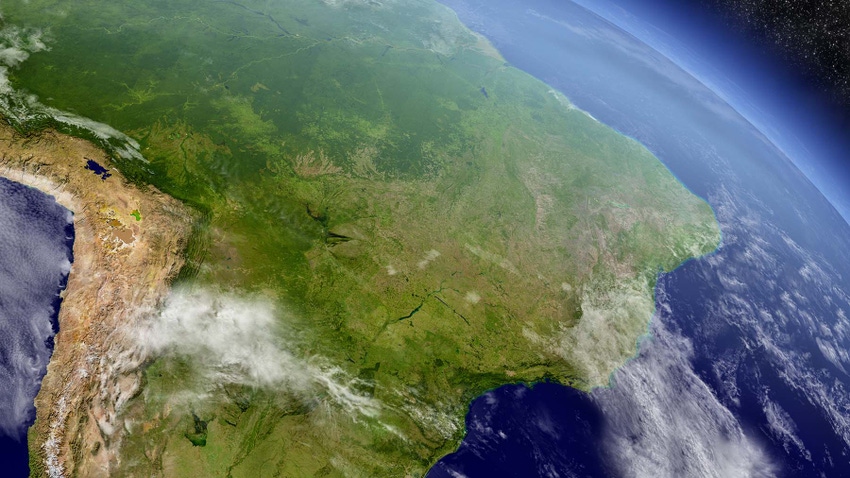
Excessive rain in southern Brazil and dryness in the central and northern areas have been affecting planting progress for 2023/2024 soybeans and the first corn crop. It is creating additional logistic challenges for the country to continue exporting record levels of agricultural commodities.
The weather in South America appears to be the main factor driving agricultural markets in most recent weeks, especially in Brazil. After feeling the effect of a multiyear La Niña, it is now time for South American producers to face what so far looks like a strong El Niño pattern that could persist for several months into 2024.
El Niño impact
According to the International Research Institute for Climate Change, in the years of El Niño, two distinct weather patterns generally affect South America. First, a longer and wetter season in the south lasting from September to January affects areas of southern Brazil, Uruguay, southern Paraguay, and northeastern areas of Argentina. Second, a longer, drier, and warmer season occurs in the northern areas of the continent from June through at least the initial months of the following year.
Currently, the southern areas of Brazil and Paraguay have had excessive rains for several weeks, and flooding is a major problem in various parts of the region. According to T-Storm Weather, southern Brazil experienced the third-wettest period (1979-2023) on record from Oct. 1 to Nov. 26. In south Brazil, adverse weather conditions could potentially affect around one-third of the country’s soybean production and nearly half of first corn production.
Planting progress
According to Brazil’s National Supply Company (Conab), as of Nov. 25, nearly 63% of the estimated soybean area in the southernmost states in the country was planted, versus 77% last year. Also, according to the agency, 87% of the first corn crop in the south was planted, versus 91% a year ago.
Since the beginning of the soybean planting season, central and northern Brazil have been fairly dry and very warm. Maximum temperatures in central Brazil have stayed in the 100s F in recent weeks, accompanied by limited precipitation and coverage. According to T-Storm Weather, Goiás and Mato Grosso states have had the driest October 1-November 26 period since 1979. The two states combined are expected to produce nearly 38% of the country's soybean production in the 2023/2024 crop year.
According to Conab, 75.2% of Brazil’s expected soybean production had been planted as of November 25, versus 86.1% last year. Around 17% of soybean areas in Mato Grosso state (approximately 27% of Brazil’s production) were planted outside the ideal window.
Second crop risk
The main concern market participants currently have regarding the delay in the soybean planting season in Brazil is its potential impact on the second crop. It represents more than 75% of the country’s total corn production and is planted after soybeans are harvested.
The late corn planting season may create additional risk to producers in both south and central Brazil. In the south, the risk of frost during the winter season in the southern hemisphere can still reduce planted area and decrease yields. Meanwhile, the risk in central-west Brazil, the main producing region for corn and soybeans, is of receiving lower precipitation during critical periods of crop development.
Due to ongoing weather conditions, producers in the south have reported problems with soil erosion, which has also led to nutrient and seed losses. Some areas have also been affected by bacterial diseases caused by high precipitation and reduced hours of sunshine. In the central and northern areas, producers are still waiting for more rain to evaluate any potential yield losses, and to decide whether to replant their soybeans.
Export market
While El Niño seems to likely affect Brazil’s corn and soybean production in 2023/2024, Argentina, Brazil, and Paraguay combined are expected to produce and export higher volumes of both commodities than in the 2022/2023 crop year (USDA). Argentina is expected to recover from its severe drought caused by La Niña, which greatly impacted the country’s corn and soybean production last year. According to the USDA, in 2023/2024, corn production in Argentina is expected to increase by 21 MMT (+61.8%), to 55 MMT, while soybean production may rise by 92%, from 25 MMT to 48 MMT. Therefore, higher production in Argentina could potentially offset lower production in Brazil. Consequently, at current conditions, U.S. corn and soybean exports will continue to face high competition from South America during the 2023/2024 crop season.
Contact Advance Trading at (800) 747-9021 or go to www.advance-trading.com.
Information provided may include opinions of the author and is subject to the following disclosures:
The risk of trading futures and options can be substantial. All information, publications, and material used and distributed by Advance Trading Inc. shall be construed as a solicitation. ATI does not maintain an independent research department as defined in CFTC Regulation 1.71. Information obtained from third-party sources is believed to be reliable, but its accuracy is not guaranteed by Advance Trading Inc. Past performance is not necessarily indicative of future results.
The opinions of the author are not necessarily those of Farm Futures or Farm Progress.
About the Author(s)
You May Also Like






